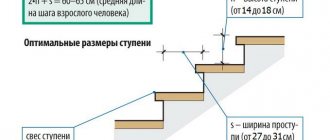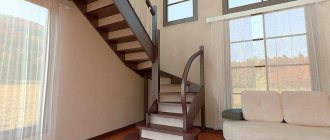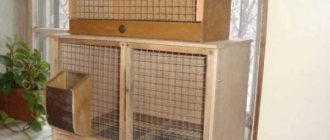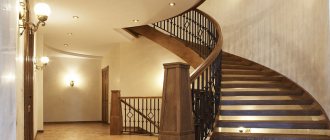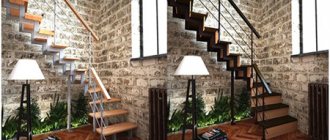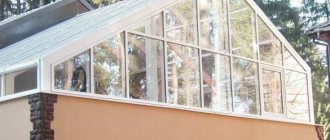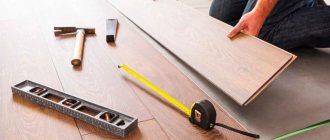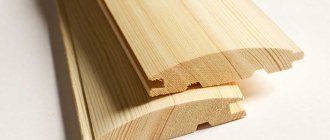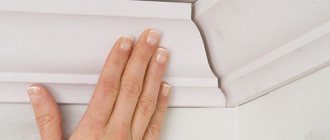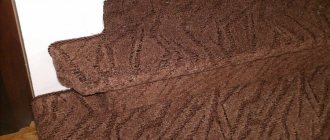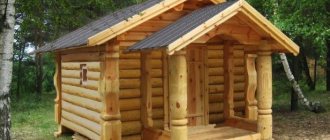02.10.2019
Varnish coating is a finishing finish that:
- adds depth to color, changes the shade of wooden surfaces;
- emphasizes the beautiful texture of wood;
- protects against biological, mechanical influences, and adverse environmental factors.
To ensure that a varnished staircase does not lose its attractiveness, you need to take into account the properties of paints and varnishes, wood and the characteristics of the place where the system is installed.
How to choose varnish for wooden stairs
After drying, the varnish forms a film of varying density and elasticity on the surface. The wooden surface takes on a glossy or matte appearance with varying degrees of light reflection - from 10 to 90 percent.
Glossy paintwork materials glare in the light and look good in dark rooms, but marks and scratches are clearly visible on them. Matte ones are less flashy, but they do not distract attention from the natural beauty of the wood and hide minor defects.
If you need to change the shade or pattern, choose colored varnishes. Transparent coatings are best applied to oak, beech and other species with a unique texture.
An important property of paintwork materials is wear resistance, which depends on its composition. The varnish for steps and handrails must have increased wear resistance, since these elements experience most of the stress from walking and moving objects. For example, parquet and yacht varnish forms a particularly durable film. Other parts can be coated with compounds with lower wear resistance, which are used for decorative finishing.
There are paints and varnishes that dry in a couple of hours, without delaying construction and repair work. Others may take three days to dry completely.
Varnishing a staircase in a house may be accompanied by a sharp, strong odor emitted by the components of some paints. You need to apply the varnish very carefully - it causes allergies, headaches, and asthma attacks. When interacting with toxic fumes, the mucous membrane of the eyes may become inflamed and the skin may become itchy.
Choose paints with protective components that increase the wood's moisture resistance, fire safety, and resistance to rot and insects. Fire protection will not harm all breeds, without exception. Oak and larch are not afraid of water, so they do not need to be coated with water-repellent compounds. Soft coniferous lumber (pine, spruce) does not rot and repels pests, but is susceptible to mechanical stress, so when choosing a varnish for a pine or spruce staircase, pay attention to its wear resistance.
Types of steps
Oak furniture and various wood accessories have never been considered cheap. This is explained by the complex preparatory process (drying and staining) of the workpieces. The result is a high quality product. Not everyone can afford to purchase oak products, however, the price does not count when the splendor and durability of the product are at stake. Therefore, when cladding flights of stairs, oak tiles are often used, guided precisely by their long service life. Oak steps last a long time without changing their positive characteristics.
There are 3 types of steps
Kinds:
- Solid. To create them, a whole piece of wood is used, and the structure of the wood pattern does not change. The main condition before installing the panels is that the wood must be kept for some time in the room where the adaptation work is supposed to be carried out.
- Solid lamella. Products are obtained by superimposing horizontal plates on top of each other. The pattern in this case is not lost.
- Spliced. The method is good if you need to create a very durable wooden structure. The method is based on merging several lamellas with tenons or grooves in the vertical direction. It is in demand when lining the treads of a flight of stairs.
How to varnish a wooden staircase
For varnishing stairs it is better to use the following compositions:
- Nitrocellulose (NC) is an organic compound of cellulose nitrate ester with resins and rosin. Used indoors for decorative finishing. Gives an even coating. Drying time: 60-90 minutes at room temperature. To obtain a high-quality film, it is better to paint another layer and leave to dry for 6-8 hours. Available in different colors, just like paint. Disadvantage: low physical and chemical resistance, sensitivity to water and direct sunlight, increased flammability.
- Polyurethane - based on hydroxy acid and alkyd-urethane resins. Without smell. They adhere tightly to the surface and do not peel off even when applied to a polished base. The coating is not afraid of impacts and abrasion. Forms an elastic, durable film that protects against water penetration and is inert to household chemicals. Resistant to high temperatures (up to 110º). Drying speed - 4-12 hours at +24-25 degrees. Low consumption - 60-100 ml per 1m2. Durability - up to 10 years. Used for high traffic stairs. There are also disadvantages. The first is that alcohol and alcohol-containing solutions leave stains on the surface that cannot be removed. Second, the two-component composition prepared for use is stored for no more than 12 hours. During this time you need to have time to paint the stairs.
- Acrylic (water-based) are the best in terms of environmental friendliness. Composition: acrylic acid + polyurethane thickener, mineral oils, additives. They do not have any unpleasant odors. Touch dry in 2-3 hours. It takes 18-36 hours to dry completely. The coatings do not scratch, are resistant to household chemicals, but are poorly resistant to temperature changes and air humidity above 50%. Designed for interior work. They do not cover the natural texture of the wood. They will protect the stairs from mold and rot. Coat following the instructions and temperature requirements. Avoid exposure to direct sunlight and drafts.
- Yacht - a group of varnishes based on urethane-alkyd, alkyd-urethane, acrylate. Durable, reliable, with a high degree of moisture resistance. Due to toxic components (toluene, xylene) they have an unpleasant, pungent odor. Vapors and smell are felt after complete drying for up to 15-30 days. The least toxic is an acrylate composition based on water-soluble components. Alkyd urethane can be used for underfloor heating systems. Drying time depends on the composition (from 45 minutes to three days). Used for varnishing street and interior stairs. We do not recommend applying it in rooms without proper ventilation, in children's rooms, or in the kitchen. Service life without re-application is up to 5 years.
- Epoxy - epoxy resin + organic solvent. The harmless varnish composition forms a durable, moisture-resistant film. It is possible to varnish external and interfloor structures - it is resistant to climatic, mechanical, chemical influences, and provides anti-corrosion. The quality of the varnish film depends on the type of resin. For example, fluoroplastic-epoxy varnishes have frost and temperature resistance and elasticity. Withstands intense sunlight. Epoxy coatings should be applied at temperatures no higher than +30 and no lower than +5, with a humidity not exceeding 80%. Drying time - 8-12 hours, complete polymerization - 48 hours.
- Alkyd - from alkyd resins, wood/linseed oil, fatty acids. Diluted with organic solvents. It is better to varnish using a spray bottle. Resistant to moisture, temperature changes, vibration loads. Protect wooden surfaces from rotting, mold and mildew. Lumber coated with this varnish does not creak because it does not stick to each other. It takes 4 days to dry completely. To speed up drying (up to 24 hours), you can add a hardener to the composition. If you do not wait for complete drying, defects will appear on the surface that will have to be removed with a sander. The painted base emits an unpleasant odor until it dries. The disadvantage of alkyd varnish is low wear resistance. Another disadvantage is that if you apply too much paint, the film will wrinkle. Varnish consumption per 1 m2 is no more than 120 g. The coating must be renewed every 2 years. After mixing with a hardener, the shelf life of the two-component composition is 8 hours.
Which varnish is best to use for painting a wooden staircase in a house depends on what result you want to get. Give preference to paintwork materials that:
- provide the tree with protection from moisture;
- favorably emphasize the surface texture;
- protect steps from damage;
- do not require updating for at least 5 years.
Finishing carpets for stairs in the house: choice
You can decorate the steps of the stairs with carpet runners. Recommended for use on straight single-flight stairs.
Important: if the base of the stairs is concrete, use special adhesive for carpeting.
The variety of carpets allows you to decorate the staircase in any style: from classic to modern.
To decorate staircase steps in a country house, many people prefer to choose carpeting.
Paths are laid using:
- Nails;
- Special clamp strips;
- Metal fasteners;
- Glue.
In specialized stores you can purchase special carpet overlays for steps.
Choosing finishing materials for the external cladding of stairs
The finishing of the steps is completed. Now you need to take care of the finishing as a whole (lining the space under the stairs, stringers and fasteners) to give the stairs a finished look.
When choosing finishing materials for stairs, you must take into account their quality, characteristics and sustainability
Usually used:
- Finishing with plywood: it is easy to sheathe a flight of stairs of any design. You can use the space under the stairs to create a pantry, mini-library, etc.
- Plasterboard finishing: used in the same way as plywood. To install the structure, first attach a frame made of a metal profile. GCR takes any shape, in addition, the material is quite light, so this finishing is easy to do with your own hands.
- Textured plaster: used to decorate plasterboard sheathing. First, all joints and fastening points are sealed with ordinary plaster, then the entire surface. After it dries, textured plaster of any color is applied.
- It is recommended to use tiles for stairs located in the kitchen or outdoors. It can be laid over the entire under-stair surface or combined with wallpaper, plaster, mosaic, etc.
This finish is suitable for marching stairs.
Screw and cantilever ones have structures that are separate from the wall; they are beautiful and light in appearance, so they do not require special finishing.
Mounting methods
The fastening is selected taking into account the material from which the staircase is made, its design, and design.
Commonly used fastening types:
- on stringers, load-bearing elements that take on the load, that is, the fasteners are responsible for fixation, prevent displacement, vibration, and have a decorative function (hides fasteners in open structures);
- with bowstrings - elements mounted on the sides.
The simplest method is through fastening with self-tapping screws to the stringer. Self-tapping screws are installed in a hidden way or decorated with plugs (consumables with decorative caps can be used).
Attention! When choosing fastening with self-tapping screws, use only feather drills, otherwise chips are likely to form at the mouths.
If the staircase is open and there is no sheathing provided, fastening with cotter pins is suitable, which involves drilling a stringer, treads, and then gluing the cotter pins.
If the system is planned to be covered, the steps are attached to the stringers with metal corners and bars.
Attachment to string:
- support bars;
- metal brackets;
- overlays imitating zigzag stringers;
- selecting grooves in the bowstring that correspond to the steps.
The simplest solution is fastening with support bars or metal brackets. Overlays and grooves are safer, more reliable, but more difficult to implement options.
Features of the structure of staircase structures
Stairs consist of flights; each has 3-18 steps. Less than 3 elements in a march is an irrational decision; if there are more than 18, the system will lose stability. For ease of use, the marches are broken up by intermediate platforms.
Steps can be made:
- straight - classic ordinary with a uniform depth throughout the entire tread;
- winder - optimal for turning flights, screw structures, characterized by narrowing on the inside and expansion along the outer edge.
This is interesting! To create the effect of lightness, the staircase is made with open elements formed only by treads. Closed options are equipped with risers that close the gap between the treads.
The steps are divided into:
- frieze (extreme) – adjacent to the lower or upper platform;
- rank and file - forming a march, located between the frieze, separated by an equal distance.
The choice of a specific type and design is made at the design stage of the house. A staircase is an element that is almost impossible to properly integrate into a ready-made cottage.
Preparatory work
If the wood is new and has not been previously treated, it must be sanded to remove cut defects. This is done twice. The first time with sandpaper with a grain size of P100-P120, the second time with a finer P180. Some beginning builders try to use even finer grit sandpaper. This should not be done under any circumstances - it will clog the pores and the oil or varnish will lie unevenly.
If the surface of the boards has darkened, it is bleached. Painted or varnished boards need to be cleaned. It is more convenient to do this with a grinder or grinder with a special disc. When sanding, small scratches may appear on the wood. To remove them, it is sanded and then dusted.
If the board has previously been treated with wax, it is washed off with white spirit or special compounds. Previously oiled wood is not sanded, but only cleaned of dirt and dust.
The nail heads are recessed a couple of millimeters into the dies. The resulting dents, as well as all damage caused during the processing process, are repaired with putty. It must be matched to the tone of the wood. To protect against rotting, the wood is additionally treated with an antiseptic.
The choice of primer depends on the type of wood. They cover boards along the grain.
Why you should contact us
Choosing a reliable supplier is an important aspect of construction. Our catalog includes wooden steps made from high-quality raw materials, manufactured in accordance with technical requirements. All goods have accompanying documents and guarantees. There are steps for choosing different staircase systems: consultants will help you navigate the variety of positions. For large customers there is a loyalty program.
- We have been working in the construction industry for 12 years.
- We install indoor and outdoor stairs in houses, cottages, and mansions.
- Any materials, shapes, sizes.
- We know all relevant GOSTs and SNiPs.
- We can do it quickly, efficiently, beautifully.
- We work under a contract and always meet deadlines.
Clinker tiles
If we talk about tiled staircases, the construction market offers no less options than with wood. A striking example of this is clinker tiles. This coating is very popular for finishing internal stairs, as it has unsurpassed wear resistance, durability and anti-slip properties. In addition, manufacturers offered a wide range of clinker tiles, rich in their variety of textures and shades. Therefore, there should be no problems with selecting finishing materials to suit every taste.
Laminate or PVC
We will not consider ordinary linoleum, because rolls are not so convenient to adjust to the desired size, unlike ready-made laminate dies and PVC tiles. They are ideal for mounting on steps.
First, a few words about laminated boards:
- In order to maintain the attractive appearance of the staircase steps, the corners must be covered with special corners;
- If you do not install a sound-absorbing substrate, then moving up the stairs will be very loud, especially at night in complete silence;
- Laminate is quite slippery, and when going downhill in socks or immediately after wet cleaning there is a high risk of slipping and falling, so it is best to use additional pads.
With PVC tiles things are much simpler. It is easy to install without problems, easy to cut and is famous for its large selection of designs.
In its structure, it is somewhat similar to household linoleum, but much stronger and more durable. For vinyl tiles, you will also need end fasteners and corners on the long side. Instead of planks, you can attach simple skirting boards, the main thing is that they match the style.
